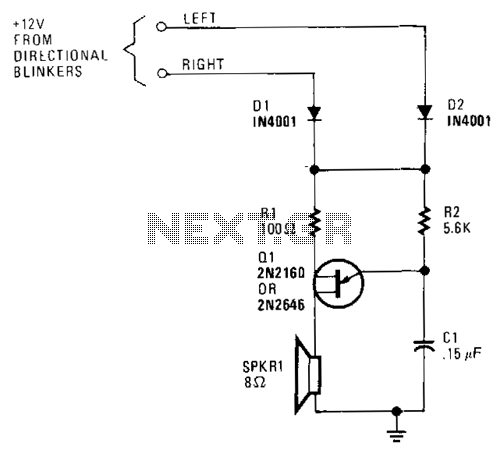
Directional-signals-monitor

A unijunction transistor audio oscillator drives a small speaker. The oscillator's frequency is determined by resistor R2 and capacitor C2. The operating voltage is supplied from the car's turn-signal circuit(s) through D1 and D2. The diodes conduct current from the blinker circuit that is energized and prevent stray current flow to the other blinker circuit.
The circuit utilizes a unijunction transistor (UJT) as the primary oscillating element. The UJT is characterized by its negative resistance region, which enables it to generate oscillations. In this configuration, the UJT is connected in such a way that it forms an oscillator circuit, with the frequency of oscillation being determined by the values of resistor R2 and capacitor C2. The choice of these components directly influences the charge and discharge time of capacitor C2, thereby establishing the output frequency that drives the connected speaker.
The power supply for this oscillator circuit is sourced from the vehicle's turn-signal circuit. Diodes D1 and D2 are employed to ensure that the circuit receives the appropriate voltage while preventing feedback or interference from other circuits within the vehicle. When one blinker circuit is activated, the corresponding diode conducts, allowing current to flow into the oscillator. This design effectively isolates the oscillator from the other blinker circuit, ensuring stable operation without unwanted cross-talk.
The small speaker connected to the output of the oscillator converts the electrical oscillations into audible sound. The frequency of the sound produced correlates with the design parameters of the oscillator, allowing for a range of audio outputs depending on the values of R2 and C2. This simple yet effective circuit design is commonly used in automotive applications to provide audible alerts or signals in conjunction with visual indicators.A unijunction transistor audio oscillator drives a small speaker. The oscillator"s frequency is determined by resistor R2 and capacitor C2. The ope rating voltage is supplied from the car"s turn-signal circuit(s) through Dl and D2. "The diodes conduct current from the blinker circuit that is energized, and prevent stray current flow to the other blinker circuit. 🔗 External reference
The circuit utilizes a unijunction transistor (UJT) as the primary oscillating element. The UJT is characterized by its negative resistance region, which enables it to generate oscillations. In this configuration, the UJT is connected in such a way that it forms an oscillator circuit, with the frequency of oscillation being determined by the values of resistor R2 and capacitor C2. The choice of these components directly influences the charge and discharge time of capacitor C2, thereby establishing the output frequency that drives the connected speaker.
The power supply for this oscillator circuit is sourced from the vehicle's turn-signal circuit. Diodes D1 and D2 are employed to ensure that the circuit receives the appropriate voltage while preventing feedback or interference from other circuits within the vehicle. When one blinker circuit is activated, the corresponding diode conducts, allowing current to flow into the oscillator. This design effectively isolates the oscillator from the other blinker circuit, ensuring stable operation without unwanted cross-talk.
The small speaker connected to the output of the oscillator converts the electrical oscillations into audible sound. The frequency of the sound produced correlates with the design parameters of the oscillator, allowing for a range of audio outputs depending on the values of R2 and C2. This simple yet effective circuit design is commonly used in automotive applications to provide audible alerts or signals in conjunction with visual indicators.A unijunction transistor audio oscillator drives a small speaker. The oscillator"s frequency is determined by resistor R2 and capacitor C2. The ope rating voltage is supplied from the car"s turn-signal circuit(s) through Dl and D2. "The diodes conduct current from the blinker circuit that is energized, and prevent stray current flow to the other blinker circuit. 🔗 External reference